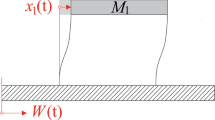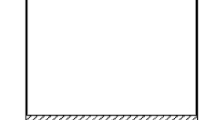Abstract
Ambient vibration modal identification, also known as Operational Modal Analysis (OMA), aims to identify the modal properties of a structure based on vibration data collected when the structure is under its operating conditions, i.e., when there is no initial excitation or known artificial excitation. This method for testing and/or monitoring historical buildings and civil structures, is particularly attractive for civil engineers concerned with the safety of complex historical structures. However, in practice, not only records of external force are missing, but uncertainties are involved to a significant extent. Hence, stochastic mechanics approaches are needed in combination with the identification methods to solve the problem. In this context, this paper’s contribution is to introduce an innovative ambient identification method based on the Hilbert Transform to obtain the analytical representation of the system response in terms of the correlation function. This approach opens the pathway for a monitoring system that is user friendly and can be used by people who have little to no knowledge of signal processing and stochastic analysis such as those who are responsible for the maintenance of a city’s historical buildings. In particular, this method operates in time domain only. Specifically, firstly the correlation functions matrix \({\mathbf{R}}_{X} \left( \tau \right)\) is determined based on the recorded time domain data. Next, performing a Singular Value Decomposition (SVD) on \({\mathbf{R}}_{X} \left( \tau \right)\) for \(\tau = 0\) leads to an estimate of the modal matrix \({\varvec{\Phi}}\) containing all the modal shapes. In this manner, once \({\varvec{\Phi}}\) is known, the entire correlation functions matrix in modal space \({\mathbf{R}}_{Y} \left( \tau \right)\) is recovered. Further, the analytical signals of the auto-correlation functions in modal space are determined performing the sum of each auto-correlation function with its Hilbert transform. Moreover, since the analytical signal can be expressed in terms of amplitude and phase, then frequencies and damping ratios estimation is possible. Finally, in order to prove the reliability of the method several numerical examples and an experimental test are reported.
Access this chapter
Tax calculation will be finalised at checkout
Purchases are for personal use only
Similar content being viewed by others
References
Brinker R, Zhang L, Andersen P (2005) An overview of operational modal analysis: major development and issues. In: Proceedings of the 1st international operational modal analysis conference. Aalborg Universitet, Copenhagen, pp 179–190
Shokravi H, Shokravi H, Bakhary N, Rahimian Koloor SS, Peetrů M (2020) Health monitoring of civil infrastructures by subspace system identification method: an overview. Appl Sci 10(8):2786–2814
Bendat JS, Piersol AG (2010) Random data: analysis and measurement procedures, 4th edn. Wiley, Hoboken
Brincker R, Zhang L, Andersen P (2000) Modal identification from ambient responses using frequency domain decomposition. In: Proceedings of the international modal analysis conference (IMAC). Aalborg Universitet, San Antonio, pp 625–630
Brincker R, Zhang L, Andersen P (2000) Output-only modal analysis by frequency domain decomposition. In: Proceedings of ISMA25. Aalborg Universitet, Leuven, pp 717–723
Welch PD (1967) The use of fast Fourier transform for the estimation of power spectra: a method based on time averaging over short, modified periodograms. IEEE Trans Audio Electroacoust 15(2):70–73
Barbé K, Pintelon R, Schoukens J (2010) Welch method revisited: nonparametric power spectrum estimation via circular overlap. IEEE Trans Signal Process 58(2):553–565
Siringoringo DM, Fujino Y (2008) System identification of suspension bridge from ambient vibration response. Eng Struct 30(2):462–477
Lardies J (2010) Modal parameter identification based on ARMAV and state-space approaches. Arch Appl Mech 80:335–352
Perez-Ramirez CA, Amezquita-Sanchez JP, Adeli H, Valtierra-Rodriguez M, Camarena-Martinez D, Romero-Troncoso RJ (2016) New methodology for modal parameters identification of smart civil structures using ambient vibrations and synchrosqueezed wavelet transform. Eng Appl Artif Intell 48:1–12
Matteo AD, Masnata C, Russotto S, Bilello C, Pirrotta A (2020) A novel identification procedure from ambient vibration data. Meccanica. https://doi.org/10.1007/s11012-020-01273-4
Cottone G, Pirrotta A, Salamone S (2008) Incipient damage identification through characteristics of the analytical signal response. Struct Control Health Monit 15(8):1122–1142
Lo Iacono F, Navarra G, Pirrotta A (2012) A damage identification procedure based on hilbert transform: experimental validation. Struct Control Health Monit 19(1):146–160
Brincker R, Ventura C (2015) Introduction to operational modal analysis. Wiley, Chichester
Di Paola M, Falsone G, Pirrotta A (1992) Stochastic response analysis of nonlinear systems under gaussian inputs. Probab Eng Mech 7(1):15–21
Pirrotta A (2005) Non-linear systems under parametric white noise input: digital simulation and response. Int J Non-Linear Mech 40(8):1088–1101
Bilello C, Di Paola M, Pirrotta A (2002) Time delay induced effects on control of non-linear systems under random excitation. Meccanica 37:207–220
Di Paola M, Pirrotta A (1999) Non-linear systems under impulsive parametric input. Int J Non-Linear Mech 34(5):843–851
Shinozuka M (1971) Simulation of multivariate and multidimensional random processes. J Acoust Soc Am 49(1B):357–368
MatLab File Exchange. https://it.mathworks.com/matlabcentral/fileexchange/69030-operational-modal-analysis-with-automated-ssi-cov-algorithm
MatLab File Exchange. https://it.mathworks.com/matlabcentral/fileexchange/50988-frequency-domain-decomposition-fdd
Acknowledgements
S. Russotto, A. Di Matteo, C. Masnata and A. Pirrotta gratefully acknowledge the support received from the Italian Ministry of University and Research, through the PRIN 2017 funding scheme (project 2017J4EAYB 002 - Multiscale Innovative Materials and Structures “MIMS”).
Author information
Authors and Affiliations
Corresponding author
Editor information
Editors and Affiliations
Appendix
Appendix
The proposed algorithm, entirely reported in this appendix, requires as input only the output signals (X) and the time vector (time). It calculates automatically the frequencies (fid), the damping ratios (Z_ID_LOG) and the modal shapes both normalized with respect to the first component of each mode (PHI_IDNN) and not-normalized (PHI_ID). The entire developed MatLab function, called TD_ASM.m, is shown below.

In this code only two kind of interactions with the user are requested. The first one is the organization of the input data i.e. the time vector that is a row vector and the structural output process that is a three-dimensional array. The second one is a step of the function TimeStopSelection.m that is contained into TD_ASM.m and that requires the choice of the time interval to be used to perform the average in Eq. (16) and to identify the coefficient \(c_{1}\) in Eq. (17). In order to simplify this step, TimeStopSelection.m has an interactive graphic interface that allows to choose, with few clicks, the aforementioned time intervals as reported in Fig. 5a, b respectively for frequency identification and damping ratios identification.
Rights and permissions
Copyright information
© 2021 The Author(s), under exclusive license to Springer Nature Switzerland AG
About this paper
Cite this paper
Russotto, S., Di Matteo, A., Masnata, C., Pirrotta, A. (2021). OMA: From Research to Engineering Applications. In: Rainieri, C., Fabbrocino, G., Caterino, N., Ceroni, F., Notarangelo, M.A. (eds) Civil Structural Health Monitoring. CSHM 2021. Lecture Notes in Civil Engineering, vol 156. Springer, Cham. https://doi.org/10.1007/978-3-030-74258-4_57
Download citation
DOI: https://doi.org/10.1007/978-3-030-74258-4_57
Published:
Publisher Name: Springer, Cham
Print ISBN: 978-3-030-74257-7
Online ISBN: 978-3-030-74258-4
eBook Packages: EngineeringEngineering (R0)





